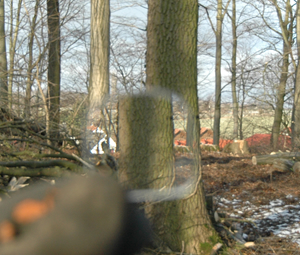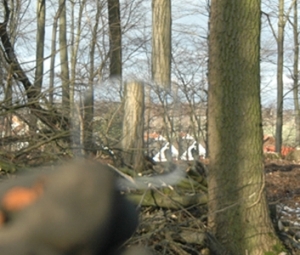Wedge prism
From AWF-Wiki
(Difference between revisions)
| (32 intermediate revisions by 2 users not shown) | |||
| Line 1: | Line 1: | ||
| − | {{ | + | {{Ficontent}} |
| + | ==General description== | ||
| + | The wedge prism is a small honed glass plate that is used to make an [[Bitterlich sampling|angle count sample]]. You can estimate [[basal area]] with [[Bitterlich_sampling#Choice_of_basal_area_factor|basal area factors]] of ½, 1, 2 or 4. Each prism has a constant factor. | ||
| + | The observer can do an [[Bitterlich sampling|angle count sample]] moving around the prism – while the prism is located at the sample point. | ||
| + | ==Handling== | ||
| + | # Select the point for [[Bitterlich sampling|angle count sample]], | ||
| + | # Select starting point (tree) for the sample, | ||
| + | # Move around the prism in a 360° sweep and count the trees included in the sample till starting point is reached, | ||
| + | # Multiply the counted number with the respective [[Bitterlich_sampling#Choice_of_basal_area_factor|basal area factor]] of the prism (the result is an estimate of basal area in m² per ha) | ||
| − | == | + | <gallery widths=300px heights=300px> |
| + | file:Wedge-prism_IN.jpg|Tree is included in the sample | ||
| + | file:Wedge-prism02_OUT.jpg|Tree is not included in the sample | ||
| + | </gallery> | ||
| + | {| class="wikitable" | ||
| + | !Advantages | ||
| + | !Disadvantages | ||
| + | |- | ||
| + | |independence of power sources (no batteries needed) | ||
| + | |no digital storage of measurement results available. | ||
| + | |} | ||
| − | + | ==Applications== | |
| − | + | * [[Bitterlich sampling]] | |
| − | [[ | + | * [[Bitterlich sampling|Angle count sample]] |
| − | [[ | + | |
| + | ==Related articles== | ||
| + | * [[Bitterlich sampling]] | ||
| + | {{improve}} | ||
| + | |||
[[category:Measurement devices]] | [[category:Measurement devices]] | ||
Latest revision as of 15:05, 5 November 2013
Contents |
[edit] General description
The wedge prism is a small honed glass plate that is used to make an angle count sample. You can estimate basal area with basal area factors of ½, 1, 2 or 4. Each prism has a constant factor. The observer can do an angle count sample moving around the prism – while the prism is located at the sample point.
[edit] Handling
- Select the point for angle count sample,
- Select starting point (tree) for the sample,
- Move around the prism in a 360° sweep and count the trees included in the sample till starting point is reached,
- Multiply the counted number with the respective basal area factor of the prism (the result is an estimate of basal area in m² per ha)
| Advantages | Disadvantages |
|---|---|
| independence of power sources (no batteries needed) | no digital storage of measurement results available. |
[edit] Applications
[edit] Related articles
| Attention!: |
This article must be enhanced to meet the AWF-Wiki quality standards! Please visit the Discussion Page of this article for details! |

